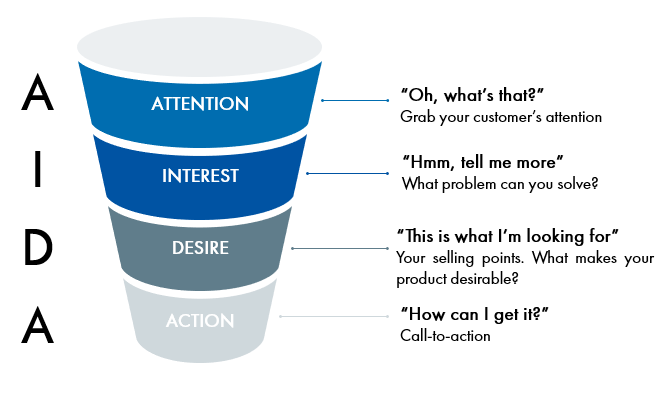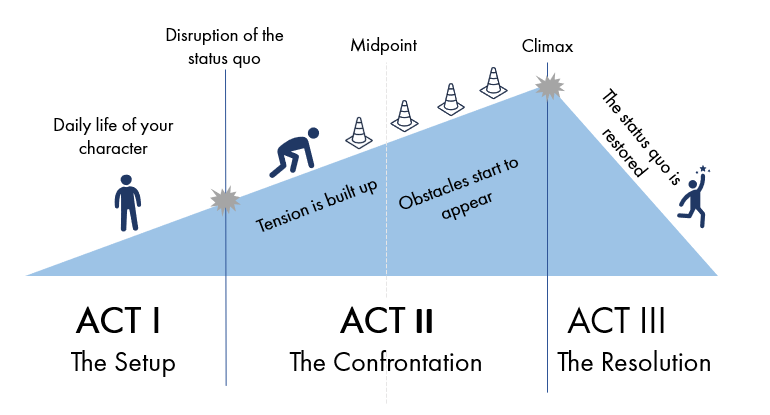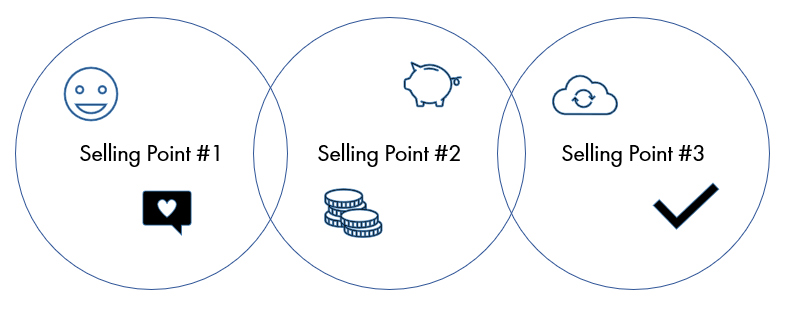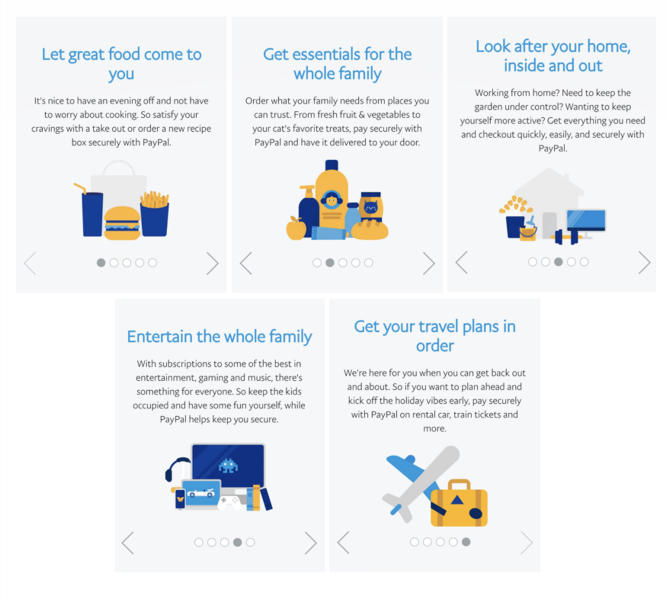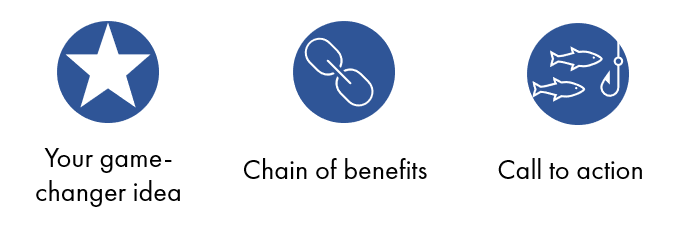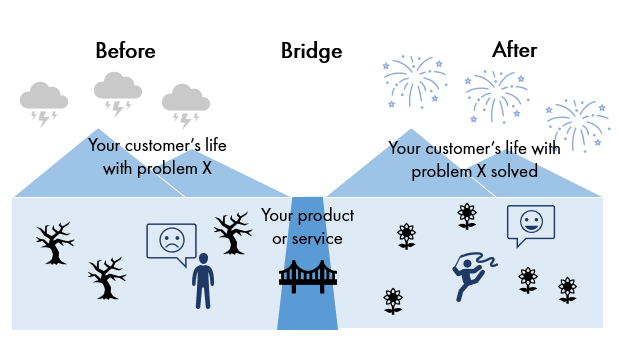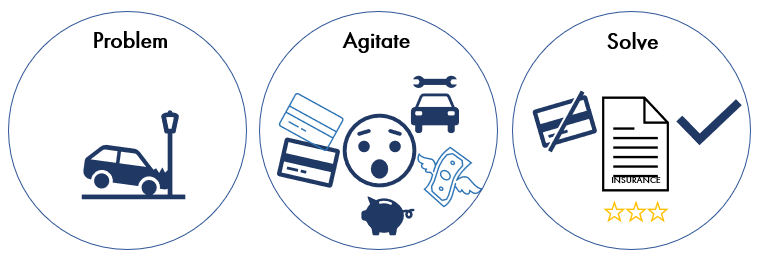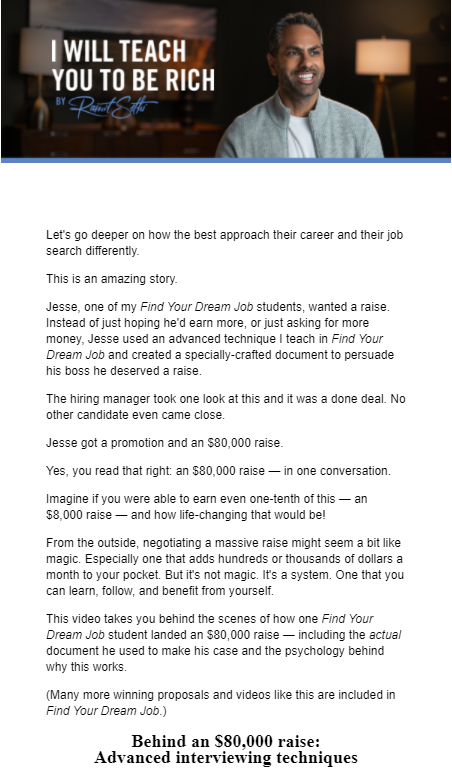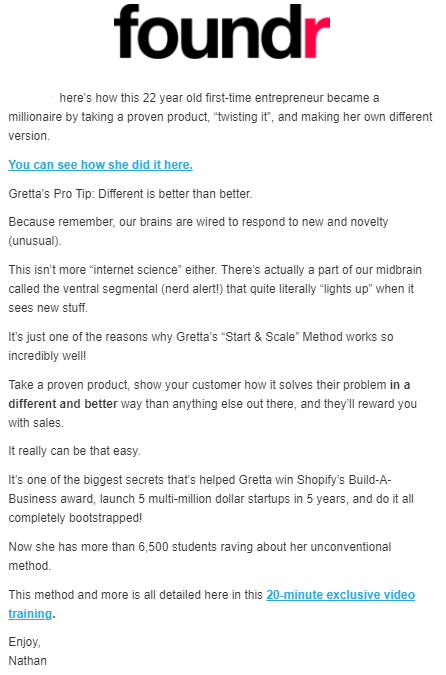19 Storytelling Formulas to Boost Your Marketing Strategy
Storytelling has become a must-have skill in marketing. As of today, people don’t want to buy any product, they want to buy from a brand that aligns with their values. But how do you communicate your values to attract the right audience?
Through stories.
Every brand has a story, and how you tell it can have your audience constantly buying from you or going to your competitors.
There are infinite ways of telling a story, but here are the most popular ones for marketing. Here you’ll find the formula that best fits your brand’s story, so you can boost your marketing strategy.
# 1. AIDA - Attention Interest Desire Action
This storytelling formula is about telling your audience why they should stop and see your product. Make your product interesting, show them why they want it, and tell them how to get it.
Alongside its acronym, this is how it works:
Attention – First you have to hook your customers. Grab their attention using a relevant headline, image, or infographic to the topic you’re addressing – or the problem you’re solving.
Interest – Appeal to their interest. What's in it for them? What can your product do for them? What’s your main benefit? What problem can you solve?
Desire – Make clear you offer add-ons. What other features have your product that makes it more desirable than others? How can your product solve your problem better than others?
Action – Tell them how they can get it. This is where you use a strong CTA. Let them know clearly what you want them to do next.
Here’s an example from the brand Function of Beauty.
# 2. The Three-Act Structure
This formula is easy to recognize as it resembles fables or tales that we have grown up with. It tells a story linearly with the usual beginning, middle (or climax), and end. Here’s how you do it.
Act I: This is the setup, where the story takes place. Here you bring your audience to your world by showing them the status quo and introducing your characters. Then, there’s an event that disrupts the status quo.
Act II: The confrontation, where the problem is built up. Your character faces a challenge while trying to restore the status quo. In this act, you have to build up tension.
Act III: The resolution, where the day is saved. The characters reach their goal or pass the challenge – be that with your product or service. The status quo is restored.
This is the simplest form of storytelling but is still as effective. Look how Amazon uses this formula for its service Amazon One here.
# 3. String of Pearls
The string of pearls is most used in advertising – for social media platforms. But a storytelling formula nonetheless. It consists of showing the selling points of your product. What are the main advantages of your product? Or what makes your product better than those of the competitors?
This storytelling formula is called the string of pearls as the features or benefits of your product are shown in the form of a carousel. The carousel has your selling points – which are the pearls – making a string with them.
Here’s an example from Paypal.
# 4. Star-Chain-Hook
For this one, imagine you have to put your product under the spotlight. People will start to wonder what that is – you grabbed their attention.
Once you have their attention you start to show off your product. And when they’re almost convinced about buying it you tell them how to get their hands on it.
The recipe goes like this:
Star – Grab your customer’s attention. What is that one problem they want to solve? Let them know how easily it can be solved with your product. Use a compelling headline.
Chain – Don’t let go of their attention. After mentioning that one problem they want to solve, start throwing a chain of benefits that your product has. Think about how these benefits are going to help solve your customer’s problem.
Hook – Let them know how to get your product. Here’s where you use a strong CTA and tell the steps that follow.
Here’s how UserWay applies this formula.
# 5. Freytag’s Pyramid or Five-Act Structure
As its name suggests this storytelling formula was created by Gustav Freytag. This one is similar to the three-act structure, but it concentrates on the climax and adds the acts of rising action and falling action.
This is how it works:
Exposition: Here’s where we see the stage of the story. We get to know the status quo and meet the characters. Nothing out of the ordinary.
Rising action: A chain of events unfolds. Conflict is built up, you can smell the tension, and challenges start to appear.
Climax: The story rises to its peak. It’s the most interesting part of the story or also known as the aha moment. The fate of our hero is settled.
Falling action: After all the excitement, in this one, the action starts to fall. This act is more about finding out if our hero accomplishes their goal or not.
Denouement: The conflict is resolved, the story ends and the status quo is restored.
You can see how Snickers does it here.
# 6. The Hero’s Journey or Monomyth
A storytelling formula that was originally made up of 17 stages, but that can be compacted into three – as a lot of people prefer simplicity.
We can see this story structure in several films. Our hero embarks on a journey and faces challenges to come back – changed or with a newfound power – and help others.
And this is how the cycle goes:
Departure: The hero is drawn into the adventure. He has a call to go on a journey
Initiation: The hero faces a chain of challenges or events and completes them.
Return: the hero comes back with a newfound power, gift, or knowledge of his journey.
This storytelling formula is depicted as a cycle as the structure repeats many times in just one story. Also, that’s the reason why it’s called a monomyth or cyclical journey.
Here’s an example of how Nissan uses this formula.
# 7. Before-After-Bridge
Here you leave the best part – your product or service – for the end. In this storytelling formula, you’re showing your customer a possibility of how their life could be better.
It goes like this:
Before: You identify a problem that your audience has. And proceed to describe the life of your audience with this problem X.
After: You picture the life of your audience if this problem X was solved. Show them the possibilities, how their life would be easier. What’s in it for them?
Bridge: This is where you show them how to get from before to after – with a bridge. And that bridge is your product.
Google uses this formula in this commercial for the Google Pixel 3.
# 8. Problem-Agitate-Solve
For this storytelling formula, you have to focus on empathy, put yourself in your audience’s shoes and understand what they’re going through.
Show your audience a problem or a challenge they’re facing. Start to build up tension around the problem with situations they encounter every day. Then, when your audience is nodding in agreement, present your solution.
These are the steps:
Problem: Identify a problem for your target audience. What’s on their mind?
Agitate: Build up the tension. Describe the challenges they have to face because of that problem, be emphatic, appeal to their pain points – agitate the problem. What’s their life like?
Solve: Present your product or service as a solution. Cover all the pain points you mentioned with your product’s features and benefits – save the day.
This one is more about understanding your audience’s daily life. Do your research.
Dr. Squatch makes a great example with its deodorant here.
# 9. Features-Advantages-Benefits
Here you want to showcase your product first, and then, start moving from your product to your customer. So it would be something like this:
“Hey, I have this product. It has these features. These features mean it has these benefits and that’s important for you because of this”.
These are the stages of it:
Features: Present the selling points of your product. The unique characteristics that make your product different.
Advantages: What do those features mean? What are the advantages that come with these features? What can you do with those features?
Benefits: Why is it important for the life of your client? What’s in it for them? How can this make their life easier?
In this formula what’s important is to let your audience know what the product can do for them.
Apple does it with its Watch Series 6 here.
# 10. Simon Sinek’s Golden Circle
Simon Sinek introduces this stellar storytelling formula. It’s called the Golden Circle because every company has these three circles: Why? How? and what?
This formula works because it goes from the inward circle, your reason, to the outside circle, the product you sell. Starting with a why makes your audience empathetic – makes them understand your story.
Then, when you tell how your product is special, you’re showing your selling points. And, in the end, you tell what your product is.
This is how you do it:
Why: why does your company or business exist? Why is your service or product important? Why should your audience care?
How: How is your product different from others? How does your product fulfill a need better than others? How is buying your product better than doing nothing?
What: What does your company do? What product do you sell that meets your why?
This is a clear example of a storytelling formula that easily showcases your values. And as a result, attracts an audience that shares those values.
You can see an example from O-I Glass here.
# 11. Dale Carnegie’s Magic Formula or Incident-Action-Benefits
In this storytelling formula, you get personal with your audience, you trigger an emotion about an incident they can relate to. Then you take an action – or your character takes an action – to show something needed to be done. When the action is taken you say the benefits of it.
These are the steps:
Incident: Something out of normal challenges the status quo of the everyday life of your character.
Action: Your character takes a certain action to face the problem. Something needs to be done.
Benefits: Show the benefits of that action – like a moral. If you want something to change you have to take action, show that.
This formula shows that to go from A to B you have to take action. And this is what Ramit Sethi shows in this example:
# 12. The Story Spine or the Pixar Formula
Originally called the story spine but renamed the Pixar formula as it is widely used by Pixar to tell stories.
This storytelling formula is simple as it provides the structure already. However, you don’t have to strictly follow it.
Have in mind the story has characters with a routine, but one day something out of the ordinary happens. Because of that, they have to leave their routine to do something else, until they finally solve whatever was wrong.
This is how Kenn Adams explains this formula using The Incredible’s plot.
# 13. Michael Hauge 6-Stage Plot Structure
This formula was created by Michael Hauge and goes like this:
The setup: Here you show the normal, the everyday life of your hero. Nothing is out of normal until a challenge, goal, or opportunity arises.
The new situation: The hero is now looking at his options and coming up with a plan to address this new situation.
The progress: The hero starts noticing the results of his efforts little by little. The hero reaches the point of no return to their ordinary.
Complications and higher stakes: More challenges start to arise, one more difficult than the other until the hero is on the brink of losing.
The final push: The hero uses the strength he has left to give one final push, and overcome the challenge.
The aftermath: The hero finishes his task and reaches his goal.
In this formula, we can see a structure similar to that of the pyramid or the three-act structure but with more sections.
# 14. Dave Lieber’s V Formula
We love seeing how a character goes from what seems like an impossible situation to saving the day at the last minute. And that’s what this storytelling formula is about.
Here’s how it works:
Meeting the hero: The setup. We meet the hero, how their life is, or any kind of backstory.
Knock the story down to its lowest point: make things go really bad for your hero. Put them in an impossible situation. Appeal to the audience’s empathy and pain points.
Pushing up against all odds: against all odds the hero lifts their way to the top, turning things around and reaching a happy ending.
It’s called the V formula because of its structure. From normal to the lowest point and going back up again.
Here’s an example from Gary Halbert in his ad The Amazing Diet Secret of a Desperate Housewife.
# 15. Nancy Duarte’s Secret Structure of Great Talks
In this storytelling formula, the idea is to go back and forth between what is and what could be. You make the present, the status quo, unappealing to your audience. While on the other hand, you make what is possible desirable.
Make the gap between what is and what could be bigger every time.
It goes like this:
What is: Describe the status quo, how is the world without your product? Here you appeal to the pain points of your audience.
What could be: Now describe the world with your product. Handle objections. How is the world better with your product?
This formula works because some people are going to resist your idea, and by going back and forth you start persuading them with more arguments.
You can see how Mel Martin applies this formula here.
# 16. From Zero to Hero*
Here you want to empathize with your audience, appeal to their pain points, and show them that their situation can be better.
You start your story at the lowest point with a problem they may have (pain points time). Then, something changes or appears in their lives that help them reach the desired reality.
The formula goes like this:
Lowest point: Start your story at the lowest point. Appeal to your audience’s pain points and emphasize their feelings.
Turning point: A discovery changes the circumstances. Things start to get better.
The now: Describe how your life – or your character’s life – is better. Draw the picture of desirable reality. Show all the benefits.
This formula works as long as you have a clear image of what your customer wants. Put yourself in their shoes.
An example of this formula is the Lazy Man’s Way to Riches by Joe Karbo.
# 17. The Idiot Saga*
The purpose of this storytelling formula is to show that anyone can make it. People like to know that it’s never too late. There's always an opportunity for them to succeed.
Here’s how it works:
The stumbles: Describe how your life – or your character’s life – stumbled. The problem you were facing. Your pain points.
The change: You start doing something new, to change. Tell them how you wish you knew the stuff you know now.
The mistakes: Describe your journey, and the mistakes you’ve done along the way.
The encouraging: Encourage your audience. Offer them the knowledge you already have to achieve what they want.
The now: Show how all your efforts gave you the life you enjoy today. Tell your audience how easier it’s going to be for them than how it was for you.
You’ve probably seen this formula in courses or book offerings.
Here’s an example of this formula from Foundr.
# 18. The Hero by Accident*
This one is about showing people a skill you have but didn't intend to learn. It works because your audience thinks: “this person is doing pretty good and he or she didn't even intend to learn this skill. But me, I'm all in, so maybe I can do better”.
This is how you do it:
The setup: The status quo. You – or your character – were living your life normally.
The problem: A problem that disturbs the normal arises, but you figure out how to solve it.
The message spreads: You start helping people or friends with the same problem. And the message spreads.
The celebrity: People start asking for your help. You become known.
The conclusion: Show how a normal person like you achieved to solve that problem.
Here’s how Mailchimp applies this formula to tell the story of its founders.
# 19. The Public Enemy*
People love being part of something, even more, when they all have the same goal, thoughts, and opinions. In this storytelling formula, your goal is to make people with the same values as you, or your company, join you against a common enemy.
It goes like this:
The problem: You talk about the problem you’re facing and how this affects your people, environment, or daily life.
Assurance: Let them know the problem it's not their fault or they weren’t aware of it.
The help: Show them how your product can help. Make the features of your product stand out.
CTA: Ask them to help you, join your community, or be part of the change because they’re not with the enemy.
Here’s how Dropps uses this storytelling formula:
Conclusion
When we buy stuff we like to think we’re being completely reasonable. That our purchase was justified. That what is in our buying cart was a need. But at the end of the day, our decisions are more emotional than we want to admit.
That’s why the most powerful stories are those that make you feel emotion. When we hear a story we feel empathy for the character, we start to wonder what would we do in their place or how would we feel. We are involved.
These kinds of stories deliver a compelling message in a way, a list of facts could never do, and ultimately makes us choose a more expensive cruelty-free body wash over a regular one.
*These formulas were taken and adapted from Alex Vargas’s post. https://www.nucleoexpert.com/guia-do-storytelling/


